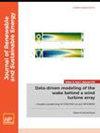Experimental study on the effect of combustion and emission performance of biodiesel–ammonia dual-fuel engine
IF 1.9
4区 工程技术
Q4 ENERGY & FUELS
引用次数: 0
Abstract
To assist vessels in meeting the net-zero emission target set by the International Maritime Organization for 2050, this article investigates the emission and combustion characteristics of biodiesel–ammonia dual-fuel engines. This research investigates the impact of various ammonia mass ratios (AMRs, m%) at 0, 14.67%, 29.48%, 46.21%, 58.73%, and 82.72% on the combustion and emission performance of biodiesel–ammonia dual-fuel engines at fixed speed and load. The results show that the biodiesel–ammonia dual-fuel engine is capable of operating at a substantial AMR of 82.72%. In addition, as the AMR increased, the in-cylinder pressure and brake thermal efficiency decreased. The heat release rate peaked at 57.13% AMR. When compared to the only-biodiesel mode, NOx, CO2, and soot emissions are significantly reduced. CO2 and soot emissions decreased by 63.43% and 60%, respectively, at 82.72% AMR, while NOx emissions fell by 34.15% at 58.73% AMR. The emissions of N2O and unburned ammonia rose linearly as AMR increased. The increase in N2O did not counteract the substantial fall in CO2e. CO2e fell by 63.12% at 82.72% AMR, following a trend to similar CO2.生物柴油-氨气双燃料发动机燃烧和排放性能影响的实验研究
为帮助船舶实现国际海事组织设定的 2050 年净零排放目标,本文研究了生物柴油-氨气双燃料发动机的排放和燃烧特性。该研究调查了不同氨气质量比(AMRs,m%)(0、14.67%、29.48%、46.21%、58.73% 和 82.72%)对生物柴油-氨气双燃料发动机在固定转速和负荷下的燃烧和排放性能的影响。结果表明,生物柴油-氨气双燃料发动机能够在 82.72% 的大幅 AMR 下运行。此外,随着 AMR 的增加,缸内压力和制动热效率都有所下降。热释放率在 AMR 为 57.13% 时达到峰值。与仅使用生物柴油的模式相比,氮氧化物、二氧化碳和烟尘排放量显著减少。在 82.72% AMR 时,二氧化碳和烟尘排放量分别减少了 63.43% 和 60%,而在 58.73% AMR 时,氮氧化物排放量减少了 34.15%。随着 AMR 的增加,N2O 和未燃烧氨的排放量呈线性上升。N2O 的增加并没有抵消 CO2e 的大幅下降。在 AMR 为 82.72% 时,CO2e 下降了 63.12%,其趋势与 CO2 相似。
本文章由计算机程序翻译,如有差异,请以英文原文为准。
求助全文
约1分钟内获得全文
求助全文
来源期刊

Journal of Renewable and Sustainable Energy
ENERGY & FUELS-ENERGY & FUELS
CiteScore
4.30
自引率
12.00%
发文量
122
审稿时长
4.2 months
期刊介绍:
The Journal of Renewable and Sustainable Energy (JRSE) is an interdisciplinary, peer-reviewed journal covering all areas of renewable and sustainable energy relevant to the physical science and engineering communities. The interdisciplinary approach of the publication ensures that the editors draw from researchers worldwide in a diverse range of fields.
Topics covered include:
Renewable energy economics and policy
Renewable energy resource assessment
Solar energy: photovoltaics, solar thermal energy, solar energy for fuels
Wind energy: wind farms, rotors and blades, on- and offshore wind conditions, aerodynamics, fluid dynamics
Bioenergy: biofuels, biomass conversion, artificial photosynthesis
Distributed energy generation: rooftop PV, distributed fuel cells, distributed wind, micro-hydrogen power generation
Power distribution & systems modeling: power electronics and controls, smart grid
Energy efficient buildings: smart windows, PV, wind, power management
Energy conversion: flexoelectric, piezoelectric, thermoelectric, other technologies
Energy storage: batteries, supercapacitors, hydrogen storage, other fuels
Fuel cells: proton exchange membrane cells, solid oxide cells, hybrid fuel cells, other
Marine and hydroelectric energy: dams, tides, waves, other
Transportation: alternative vehicle technologies, plug-in technologies, other
Geothermal energy
 求助内容:
求助内容: 应助结果提醒方式:
应助结果提醒方式:


